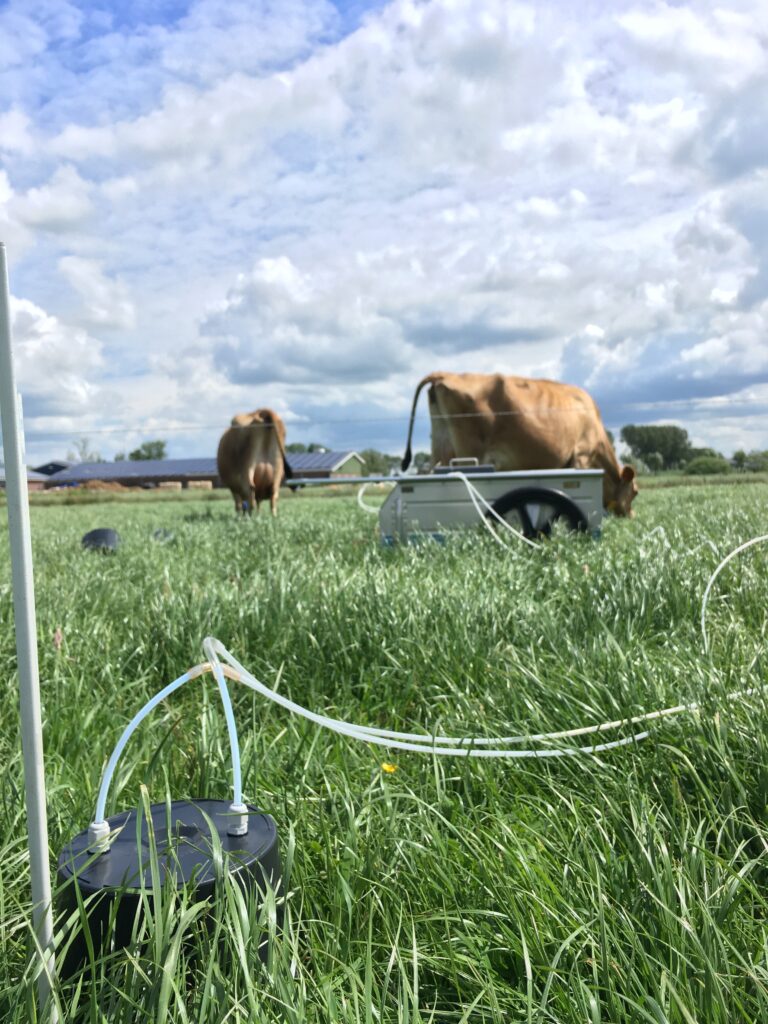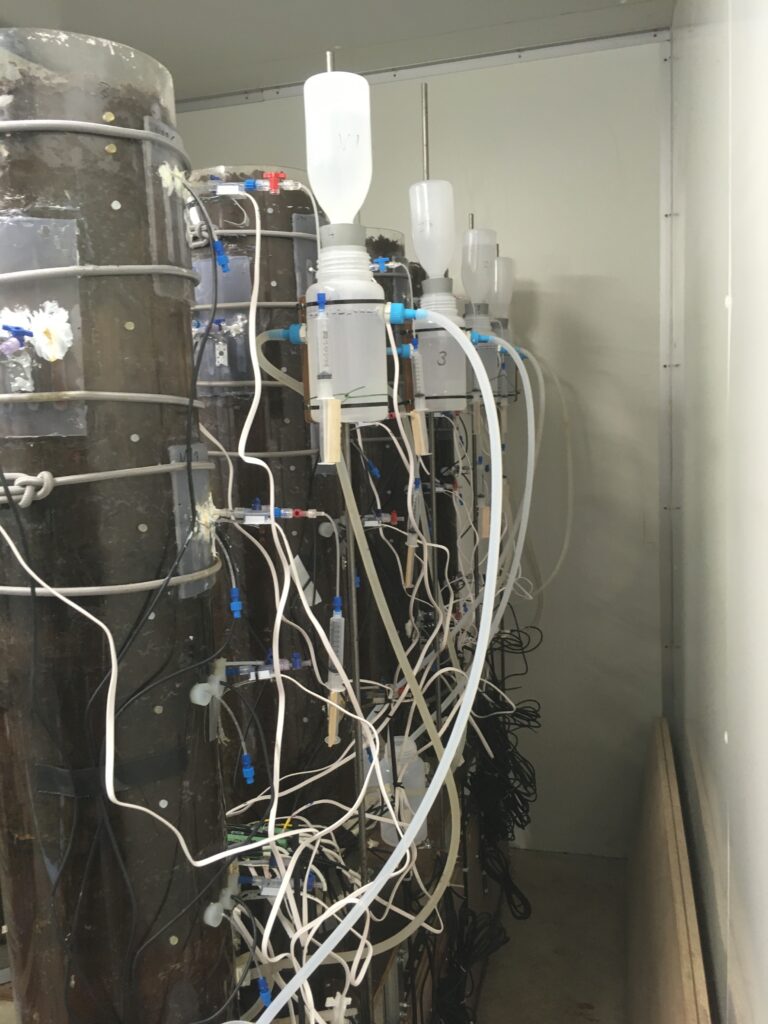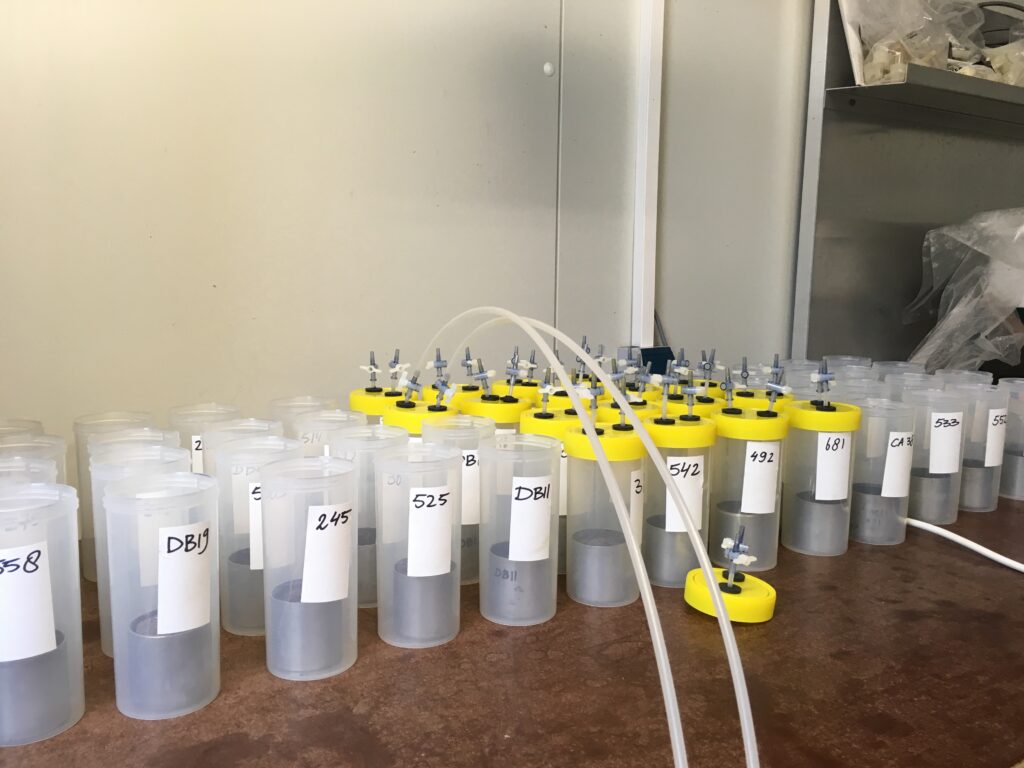WP2.3 – Greenhouse gas production and shrinkage-swelling in peat
Introduction
Peat soils play an important role in the global carbon cycle, through their ability to sequester large stocks of carbon 1,2. This carbon pool is under threat, as peat areas around the world have been actively drained for centuries to make the soil suitable for agriculture or forestry 3. This results in decomposition of peat and subsequent emission of the greenhouse gases carbon dioxide (CO2) and nitrous oxide (N2O) to the atmosphere 4,5,6, as well as subsidence of the soil surface7. On the other hand, the aeration of peat soils inhibits production of methane (CH4), which is the dominant greenhouse gas (GHG) emitted from wetlands under the naturally occurring anaerobic conditions 5.
21% of grasslands and 10% of cropslands in the Netherlands are situated on organic (peat or peaty) soils 8. Drainage of peat soils in the Netherlands caused an emission of 5.6 Mton CO2 and 2.3 kton N2O in 2018, and is resulting in a steady decline in the area classified as peat soil due to soil carbon loss 9. Since the Netherlands have formulated a general goal to reduce emissions from grasslands on peat soils with 1 Mton CO2-equivalent by 2030, a detailed and integral policy plan to reach this goal will be indispensable 10,11.
Objectives and methods
This research project focusses on the mitigation of organic matter oxidation and associated greenhouse gas emissions and subsidence from peat meadows in the Netherlands. This involves two main themes. First we direct our attention to the question how we can reduce the oxidation of peat and the resulting greenhouse gas emissions and subsidence through groundwater level management in a changing climate. Microbial oxidation of the organic matter composing peat, is limited by both O2 and moisture availability 4,12. The effect of water content on oxidation can therefore work two ways. Similarly N2O emissions are limited by both aeration and water content as they affect nitrification (and thus NO3– availability) and denitrification13.
To understand how groundwater levels affect peat oxidation, we must first understand its effect on soil moisture content. The volumetric moisture content of managed peat soils depends on the soil composition and is affected by the interactions of water management, evaporation and the volume changes resulting from moisture changes 14. The following two research questions are therefore addressed in lab experiments (figures 1 and 2):
1. How are the soil moisture content and air filled pore space of managed peat grasslands affected by ground water levels?
2. How is peat oxidation across the soil profile controlled by the interaction of moisture, oxygen and temperature conditions?
- Figure 1: Lab experiment on undisturbed peat soil columns.
- Figure 2: CO2 and N2O flux measurements on peat and clay samples in a respiration experiment
Secondly we have a closer look at N2O emissions from peat meadows. Besides the soil moisture conditions, important factors in the production of this GHG are fertilizer application and grazing by cows.
Part of the nitrogen applied through fertilizers is usually not taken up by the grass roots, and is instead transformed to N2O. The type of fertilizer matters in the extent of this, since the commonly used fertilizer types (e.g. artificial fertilizer, cattle slurry) differ in nitrogen composition 15. Similarly, grazing by cows results in N2O emissions associated with urine and slurry application to the soil 16. In addition to that, the soil compaction caused by trampling hoofs, can be beneficial to N2O production, particularly in combination with high soil moisture. This was shown in experiments on mineral soil 17, but has not yet been studied on peat soils. Large parts of the Dutch rural peat area are used to cultivate grass for cattle feed. When formulating strategies to reduce GHG emissions from the Dutch rural peat areas, the factors of fertilization and grazing must therefore be considered. Knowledge is lacking however, on the role of these factors in N2O emissions from peat soils, or how they interact with the groundwater level. This leads us to research questions 3 and 4, which are addressed in two field experiments (figure 3):
3. How can we minimize N2O emissions from managed peat grasslands under conditions of raised GWL by adapting the fertilizer strategy?
4. How does raising the GWL together with the implications of cow grazing (soil compaction, urine and dung deposition) affect N2O production in managed peat grasslands?

Figure 3: Greenhouse gas flux measurements in one of the field experiment on the experimental farm KTC Zegveld
Contact
The PhD candidate working on WP 2.3 is Erne Blondeau (WU, Soil Biology group), supervised by Jan Willem van Groenigen (WU), Gerard Velthof (WENR), Marius Heinen (WENR) and Jan van den Akker (WENR). The research started 1 September 2020. For more information on this research, please contact Erne Blondeau at:
email: erne.blondeau@wur.nl
LinkedIn: www.linkedin.com/in/erne-blondeau-949a73135
References
1
Loisel, J., Yu, Z. C., Beilman, D. W., Camill, P., Alm, J., Amesbury, M. J., . . . Zhou, W. J. (2014). A database and synthesis of northern peatland soil properties and Holocene carbon and nitrogen accumulation. Holocene, 24(9), 1028-1042. doi:10.1177/0959683614538073
2
Yu, Z. C., Loisel, J., Brosseau, D. P., Beilman, D. W., & Hunt, S. J. (2010). Global peatland dynamics since the Last Glacial Maximum. Geophysical Research Letters, 37. doi:10.1029/2010gl043584
3
FAO. (2014). Towards climate-responsible peatlands management. Retrieved from Rome, Italy:
4
Berglund, O., & Berglund, K. (2011). Influence of water table level and soil properties on emissions of greenhouse gases from cultivated peat soil. Soil Biology & Biochemistry, 43(5), 923-931. doi:10.1016/j.soilbio.2011.01.002
5
Kasimir-Klemedtsson, A., Klemedtsson, L., Berglund, K., Martikainen, P., Silvola, J., & Oenema, O. (1997). Greenhouse gas emissions from farmed organic soils: a review. Soil Use and Management, 13(4), 245-250. doi:10.1111/j.1475- 2743.1997.tb00595.x
6
Tiemeyer, B., Borraz, E. A., Augustin, J., Bechtold, M., Beetz, S., Beyer, C., . . . Zeitz, J. (2016). High emissions of greenhouse gases from grasslands on peat and other organic soils. Global Change Biology, 22(12), 4134-4149. doi:10.1111/gcb.13303
7
Schothorst, C. J. (1977). SUBSIDENCE OF LOW MOOR PEAT SOILS IN WESTERN NETHERLANDS. Geoderma, 17(4), 265-291. doi:10.1016/0016-7061(77)90089-1
8
Arets, E.J.M.M., S.A. van Baren, H. Kramer, J.P. Lesschen & M.J. Schelhaas (2022). Greenhouse gas reporting of the LULUCF sector in the Netherlands; Methodological background, update 2022. Wettelijke Onderzoekstaken Natuur & Milieu, WOt-technical report 217
9
RIVM. (2020). Greenhouse gas emissions in the Netherlands 1990–2018, National Inventory Report 2020. Retrieved from Bilthoven, the Netherlands
10
Ministerie van Landbouw, N. e. V. (2019). Klimaatakkoord- C4 Landbouw en Landgebruik. Den Haag
11
Raad voor de leefomgeving en infrastructuur. (2020). Stop bodemdaling in veenweidegebieden: Het Groene Hart als voorbeeld. Den Haag
12
Norberg, L., Bergiund, O., & Bergiund, K. (2018). Impact of drainage and soil properties on carbon dioxide emissions from intact cores of cultivated peat soils. Mires and Peat, 21. doi:10.19189/MaP.2017.OMB.284
13
van Beek, C. L., Pleijter, M., Jacobs, C. M. J., Velthof, G. L., van Groenigen, J. W., & Kuikman, P. J. (2010). Emissions of N2O from fertilized and grazed grassland on organic soil in relation to groundwater level. Nutrient Cycling in Agroecosystems, 86(3), 331-340. doi:10.1007/s10705-009-9295-2
14
Previati, M., Canone, D., Iurato, E., Gisolo, D., Ferrari, S., Teatini, P., Putti, M., Ferraris, S., 2020. Thorough wetting and drainage of a peat lysimeter in a climate change scenario. Hydrol. Process. 34 (5), 1269–1284. https://doi.org/10.1002/hyp.13675.
15
Velthof, G. L., Kuikman, P. J. and Oenema, O. (2003). Nitrous oxide emission from animal manures applied to soil under controlled conditions. Biology and Fertility of Soils, 37, 221-230.
16
Chadwick, D. R., Cardenas, L. M., Dhanoa, M. S., Donovan, N., Misselbrook, T., Williams, J. R., Thorman, R. E., McGeough, K. L., Watson, C. J., Bell, M., Anthony, S. G., & Rees, R. M. (2018). The contribution of cattle urine and dung to nitrous oxide emissions: Quantification of country specific emission factors and implications for national inventories. Science of the Total Environment, 635, 607–617.
17
Van Groenigen J. W., Kuikman P. J., De Groot W. J. M. and Velthof G. L. (2005). Nitrous oxide emission from urine-treated soil as influenced by urine composition and soil physical conditions. Soil Biology and Biochemistry. 37, 463–473.



